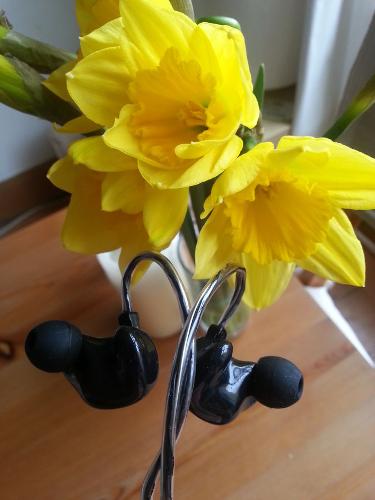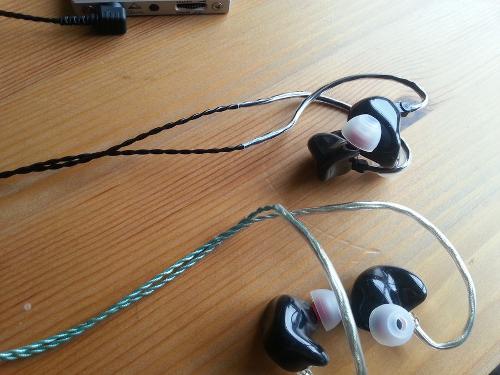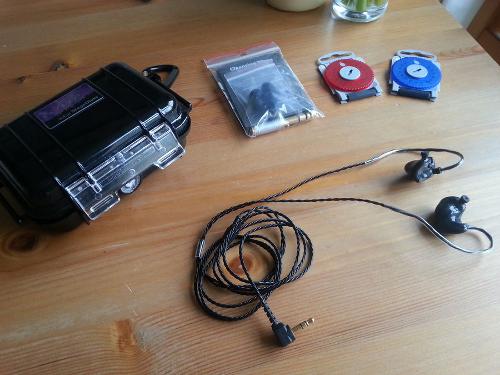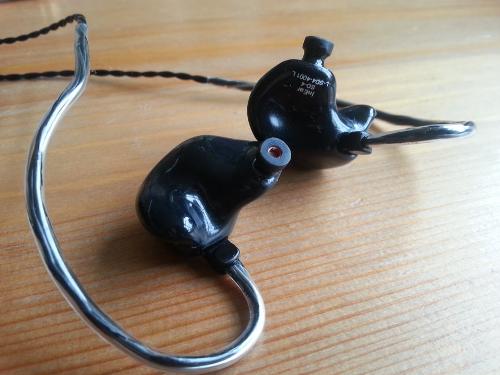Background
Just to give a little background, this is my first review for head-fi. I have been a relatively active member now for a few years since joining way back when circa 2009 when I was teaching English in Japan. My first foray discussing all things headphone with fellow headfi’ers convinced me then to pair a new AKG k450 with my Cowon X5, and ever since I have pursued a mission of smooth highs which has ultimately taken me away from bass and more towards neutrality. I moved from my x5/k450 setup to a Cowon J3 and the Etymotic HF5 , then a Samsung S3/Apex Glacier dac/amp to the classic ER4S. But recently I have been searching for a more immersive experience on the go, having sold off most of my home rig due to lack of use. I still have my trusty HD650s under my bed and still hold them as a benchmark for the kind of sound I love. However time is time and money is money and with a job requiring a lengthy commute by train I am firmly in IEM land for now.
From SD-2 to SD-4
I moved away from the ER4S neutrality (albeit conservatively), buying a pair of Stagediver SD-2 iems last October. I really enjoyed the nice bump in their bass over the ER4S and the more 3D soundstage and more balanced all-round presentation. But I still found myself thinking of the nice, more laid back bassy and immersive sound of my HD650s. I have enjoyed talking with the community on the SD-2/SD-3 thread and heard about Inear’s new SD-4, a 4 driver 2 way iem. Billed as a Stagediver with a more holographic and bassy sound than the SD-2, I was eager to try it out. On a whim I emailed Marco from Inear and he was willing to send me an SD-4 for review. Lucky me!
Build Quality
Compared to the SD-2 the SD-4 on first glance is quite similar in appearance. Its shell, accommodating an extra two drivers is surprising compact, and is only slightly thicker across compared to its smaller brother. Also Inear have now moved to a black cable for all their models, as the previous clear cable (which I have on my SD-2s) turns green after a while due to natural oxidation processes. Personally I do not mind the change in colour but the black cable did look quite smart and less conspicuous so I can perfectly understand the reasoning behind the change. Also one definite improvement in build quality between my own SD-2 and the SD-4 is at the joint where the sound nozzle enters the iem main body. On my SD-2 the surface is ridged yet on the SD-4 it is totally smooth. Not an imperative feature but it is nice to see Inear striving for perfection in their products.
Accessories
The SD-4 come with nearly all the same accessories I had with my SD-2. You get a nice sturdy Pelican carrying case, a zipbag with some cleaning wipes, a mini-jack adaptor for use with larger amps and of course an assortment of tips. For the purposes of the review Marco sent me the spare filters as seen in the photo. These are an extra you can purchase from Inear’s website directly. With my ER4S I waited a year to change the filters that come with that iem, and yes the change does make a sonic difference. The year long care I gave them (even taking a cue from Tyll Hertsens to use Japanese wax cleaners) could not stop some microscopic debris or dust from gathering over the grill. So getting some spare filters are a good idea in the long term imo.
The Sound
In a word, the SD-4s sound ‘natural’. Another word could be ‘immersive’. Some other descriptors could be ‘front row’, ‘in the mix’, ‘just put them in and forget they are there’, and the Michael Mercer classic ‘they just bring you closer to the music’.
So all very good things! All which distinguish the SD-4 hugely from its little brother the SD-2, which in comparison, though neutral and well implemented, in direct A-B testing comes across as more piercing and sibilant, with vocals sounding a bit more harsh and shouty in their decay and the overall experience more akin to the brain knowing you are ‘observing a nice performance’ rather than the SD-4’s more believable, though more rolled-off signature. The immersiveness does come at the cost of forward mids I found, with the bass and highs spreading around you and putting you in the midst of the performance. So the V-shape is not a bad thing. It seems to me a great approach to what the designers intended, which from chatting to Marco of Inear via Gmail, was to render a balanced and highly immersive sonic experience. Goal achieved in my book.
What I want to talk more about is the ‘ambient fuzz’. Ok what does that even mean? Well, in looking at and feeling the differences between the neutral SD-2 and the ‘natural’ SD-4 I equated it to how it feels to witness a good recording from slightly afar next to being at the gig itself. Feeling the reverb of the slightly distorting bass off the stage cabinets and knowing you are at a live music show. This is the SD-4. What I mean by that is the rolled off treble and extra bass of the SD-4 led to my brain’s extra belief that I am right in there with the artists and enjoying them just metres away like at a live gig. Hence my review title Putting the ‘Fun’ in Pro Audio’. But let’s do some song comparisons between the SD-2 and SD-4 to elaborate. If you click through on the youtube links and are the lucky owner of a stagediver iem (or two) then my words may make direct sense but for those others reading having yet to try an Inear Stagediver iem … well take it all as points of reference.
Some Songs for Comparisons with SD-2
Low – Words
https://www.youtube.com/watch?v=mrUoK_TvVa8
A lovely song I constantly use for trying out new phones. Lots of space to let me see how each instrument is presented.
SD-2 – vivid cymbals yet the bass sounds quite dry and hard edged (but nice). The vocals are also nicely separated from the lows and highs. It’s all very spacious and coherent. I found the soundstage stopped just under my skull and had descent depth. The bass is certainly there but it is the mids that really pop with energy with the highs being relatively present too.
SD-4 – the bass line is more rounded and wet sounding, and potentially a touch boomy but it sounds great and more real. Cymbals are very different! They sound flatter like they are more rolled off yet somehow they hit with more impact than on the SD-2s. Vocals are also a little further back in the mix and ‘groove’ in the song more than ‘pop’ as with the SD-2s. The bass which is in general much improved over the SD-2s can at times blend more into the mids but again I found this totally fine. Even when it does the highs are totally unaffected. Lastly, though at first blush I thought the soundstage on the SD-4 may be narrower it is due to you being more at the centre of things. Which in my book is always the preference in an iem or headphone.
Cliff Martinez - Solaris OST 2002 – Is that what everybody wants
https://www.youtube.com/watch?v=Jintml12qaY
SD-4 – I in fact have hardly any notes with the SD-4 as I drifted off with them in my ears. All in all they just connected me with the track and its dream like composition carried me off. Total win for how effortlessly engaging and natural the SD-4 are.
SD-2 – Compared to the SD-4 they are more distant but still very coherent sounding iems. They felt more analytical and less likely to send you into a murk of music induced dreamland. Perhaps they were a touch more spacious than the SD-4s yet I felt in this spaciousness I was observing the track more than emotionally participating in it as I was with the SD-4s.
Stars of the Lid – Requiem for Dying Mothers Part 2 & Down 3
https://www.youtube.com/watch?v=uQ7CU9QIHAA
https://www.youtube.com/watch?v=MHfZOwK-Yn0
Requiem for Dying Mothers Part 2 is a great track to test how an iem can generate a nice low sub-bass rumble. The SD-4 does this very well for a BA driver iem and is really engaging and enjoyable. It is the end of the next track Down 3 however, with the recording of a tram accelerating off its station that the SD-4 shows its true quality. Compared to the SD-2 the SD-4 renders the field recording in a magical way that makes the brain think not of , again, observing something cold and in a calculated way, but how the brain may remember a similar set of sounds watching a TV in childhood. The sounds on the SD-4 appear the way the brain thinks they should. It’s all very hard to describe but emotionally it is there and is very real. By being less neutral and more analogue the SD-4s achieve a means to make you feel included in what your ears are hearing. You are there!
Few last words
One thing I also really appreciated with the SD-4 was that if there was no obvious bass in a track it was almost like they became an SD-2.5 , and the mids and highs dominated effortlessly and very coherently despite the lack of the lower frequencies.
Also I had some spintfit tips on hand to try out with the SD-4 and I found they vastly improved the comfort from the standard tips. As they pivot they allowed for deeper insertion and as the jaw moves so do they and so all round comfort is massively improved. Not that the stock tips are bad at all but if you do struggle be safe in the knowledge that the spin fits fit the Stagedivers perfectly and besides comfort also noticeably improve transparency, and with a nice seal, bass also.
So all in all would I recommend the SD-4? If you understand and are happy with the type of sound balanced armature drivers produce and want an iem with a great immersive soundstage, lovely sense of a live performance and enjoy also the unique aesthetic Inear have brought to the shell design then yes , if you can afford it, please go ahead and grab one! I doubt you will regret it.
Thanks again to Inear for loaning me the SD-4 for 2 weeks for this review. Happy Spring!





Just to give a little background, this is my first review for head-fi. I have been a relatively active member now for a few years since joining way back when circa 2009 when I was teaching English in Japan. My first foray discussing all things headphone with fellow headfi’ers convinced me then to pair a new AKG k450 with my Cowon X5, and ever since I have pursued a mission of smooth highs which has ultimately taken me away from bass and more towards neutrality. I moved from my x5/k450 setup to a Cowon J3 and the Etymotic HF5 , then a Samsung S3/Apex Glacier dac/amp to the classic ER4S. But recently I have been searching for a more immersive experience on the go, having sold off most of my home rig due to lack of use. I still have my trusty HD650s under my bed and still hold them as a benchmark for the kind of sound I love. However time is time and money is money and with a job requiring a lengthy commute by train I am firmly in IEM land for now.
From SD-2 to SD-4
I moved away from the ER4S neutrality (albeit conservatively), buying a pair of Stagediver SD-2 iems last October. I really enjoyed the nice bump in their bass over the ER4S and the more 3D soundstage and more balanced all-round presentation. But I still found myself thinking of the nice, more laid back bassy and immersive sound of my HD650s. I have enjoyed talking with the community on the SD-2/SD-3 thread and heard about Inear’s new SD-4, a 4 driver 2 way iem. Billed as a Stagediver with a more holographic and bassy sound than the SD-2, I was eager to try it out. On a whim I emailed Marco from Inear and he was willing to send me an SD-4 for review. Lucky me!
Build Quality
Compared to the SD-2 the SD-4 on first glance is quite similar in appearance. Its shell, accommodating an extra two drivers is surprising compact, and is only slightly thicker across compared to its smaller brother. Also Inear have now moved to a black cable for all their models, as the previous clear cable (which I have on my SD-2s) turns green after a while due to natural oxidation processes. Personally I do not mind the change in colour but the black cable did look quite smart and less conspicuous so I can perfectly understand the reasoning behind the change. Also one definite improvement in build quality between my own SD-2 and the SD-4 is at the joint where the sound nozzle enters the iem main body. On my SD-2 the surface is ridged yet on the SD-4 it is totally smooth. Not an imperative feature but it is nice to see Inear striving for perfection in their products.
Accessories
The SD-4 come with nearly all the same accessories I had with my SD-2. You get a nice sturdy Pelican carrying case, a zipbag with some cleaning wipes, a mini-jack adaptor for use with larger amps and of course an assortment of tips. For the purposes of the review Marco sent me the spare filters as seen in the photo. These are an extra you can purchase from Inear’s website directly. With my ER4S I waited a year to change the filters that come with that iem, and yes the change does make a sonic difference. The year long care I gave them (even taking a cue from Tyll Hertsens to use Japanese wax cleaners) could not stop some microscopic debris or dust from gathering over the grill. So getting some spare filters are a good idea in the long term imo.
The Sound
In a word, the SD-4s sound ‘natural’. Another word could be ‘immersive’. Some other descriptors could be ‘front row’, ‘in the mix’, ‘just put them in and forget they are there’, and the Michael Mercer classic ‘they just bring you closer to the music’.
So all very good things! All which distinguish the SD-4 hugely from its little brother the SD-2, which in comparison, though neutral and well implemented, in direct A-B testing comes across as more piercing and sibilant, with vocals sounding a bit more harsh and shouty in their decay and the overall experience more akin to the brain knowing you are ‘observing a nice performance’ rather than the SD-4’s more believable, though more rolled-off signature. The immersiveness does come at the cost of forward mids I found, with the bass and highs spreading around you and putting you in the midst of the performance. So the V-shape is not a bad thing. It seems to me a great approach to what the designers intended, which from chatting to Marco of Inear via Gmail, was to render a balanced and highly immersive sonic experience. Goal achieved in my book.
What I want to talk more about is the ‘ambient fuzz’. Ok what does that even mean? Well, in looking at and feeling the differences between the neutral SD-2 and the ‘natural’ SD-4 I equated it to how it feels to witness a good recording from slightly afar next to being at the gig itself. Feeling the reverb of the slightly distorting bass off the stage cabinets and knowing you are at a live music show. This is the SD-4. What I mean by that is the rolled off treble and extra bass of the SD-4 led to my brain’s extra belief that I am right in there with the artists and enjoying them just metres away like at a live gig. Hence my review title Putting the ‘Fun’ in Pro Audio’. But let’s do some song comparisons between the SD-2 and SD-4 to elaborate. If you click through on the youtube links and are the lucky owner of a stagediver iem (or two) then my words may make direct sense but for those others reading having yet to try an Inear Stagediver iem … well take it all as points of reference.
Some Songs for Comparisons with SD-2
Low – Words
https://www.youtube.com/watch?v=mrUoK_TvVa8
A lovely song I constantly use for trying out new phones. Lots of space to let me see how each instrument is presented.
SD-2 – vivid cymbals yet the bass sounds quite dry and hard edged (but nice). The vocals are also nicely separated from the lows and highs. It’s all very spacious and coherent. I found the soundstage stopped just under my skull and had descent depth. The bass is certainly there but it is the mids that really pop with energy with the highs being relatively present too.
SD-4 – the bass line is more rounded and wet sounding, and potentially a touch boomy but it sounds great and more real. Cymbals are very different! They sound flatter like they are more rolled off yet somehow they hit with more impact than on the SD-2s. Vocals are also a little further back in the mix and ‘groove’ in the song more than ‘pop’ as with the SD-2s. The bass which is in general much improved over the SD-2s can at times blend more into the mids but again I found this totally fine. Even when it does the highs are totally unaffected. Lastly, though at first blush I thought the soundstage on the SD-4 may be narrower it is due to you being more at the centre of things. Which in my book is always the preference in an iem or headphone.
Cliff Martinez - Solaris OST 2002 – Is that what everybody wants
https://www.youtube.com/watch?v=Jintml12qaY
SD-4 – I in fact have hardly any notes with the SD-4 as I drifted off with them in my ears. All in all they just connected me with the track and its dream like composition carried me off. Total win for how effortlessly engaging and natural the SD-4 are.
SD-2 – Compared to the SD-4 they are more distant but still very coherent sounding iems. They felt more analytical and less likely to send you into a murk of music induced dreamland. Perhaps they were a touch more spacious than the SD-4s yet I felt in this spaciousness I was observing the track more than emotionally participating in it as I was with the SD-4s.
Stars of the Lid – Requiem for Dying Mothers Part 2 & Down 3
https://www.youtube.com/watch?v=uQ7CU9QIHAA
https://www.youtube.com/watch?v=MHfZOwK-Yn0
Requiem for Dying Mothers Part 2 is a great track to test how an iem can generate a nice low sub-bass rumble. The SD-4 does this very well for a BA driver iem and is really engaging and enjoyable. It is the end of the next track Down 3 however, with the recording of a tram accelerating off its station that the SD-4 shows its true quality. Compared to the SD-2 the SD-4 renders the field recording in a magical way that makes the brain think not of , again, observing something cold and in a calculated way, but how the brain may remember a similar set of sounds watching a TV in childhood. The sounds on the SD-4 appear the way the brain thinks they should. It’s all very hard to describe but emotionally it is there and is very real. By being less neutral and more analogue the SD-4s achieve a means to make you feel included in what your ears are hearing. You are there!
Few last words
One thing I also really appreciated with the SD-4 was that if there was no obvious bass in a track it was almost like they became an SD-2.5 , and the mids and highs dominated effortlessly and very coherently despite the lack of the lower frequencies.
Also I had some spintfit tips on hand to try out with the SD-4 and I found they vastly improved the comfort from the standard tips. As they pivot they allowed for deeper insertion and as the jaw moves so do they and so all round comfort is massively improved. Not that the stock tips are bad at all but if you do struggle be safe in the knowledge that the spin fits fit the Stagedivers perfectly and besides comfort also noticeably improve transparency, and with a nice seal, bass also.
So all in all would I recommend the SD-4? If you understand and are happy with the type of sound balanced armature drivers produce and want an iem with a great immersive soundstage, lovely sense of a live performance and enjoy also the unique aesthetic Inear have brought to the shell design then yes , if you can afford it, please go ahead and grab one! I doubt you will regret it.
Thanks again to Inear for loaning me the SD-4 for 2 weeks for this review. Happy Spring!


































